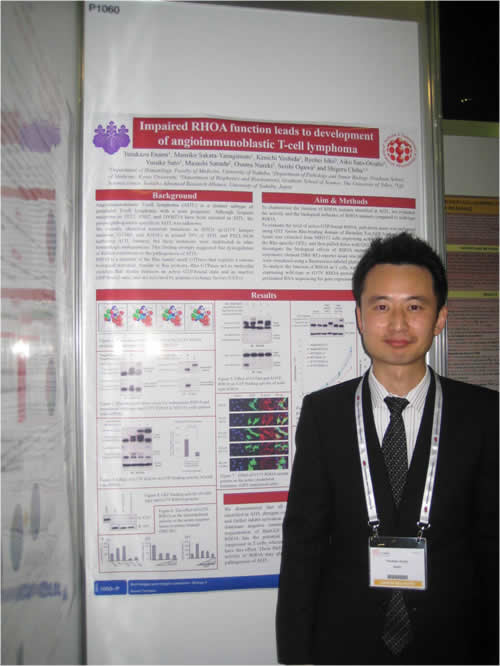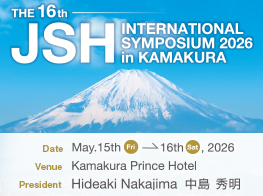
名前:榎並 輝和 【筑波大学附属病院血液内科】
発表日時:2014年6月14日
発表形式:Poster
Title:
Impaired RHOA function leads to development of angioimmunoblastic T-cell lymphoma
Authors:
Terukazu Enami1, Mamiko Sakata-Yanagimoto1, Kenichi Yoshida2,3, Ryohei Ishii4, Aiko Sato-Otsubo2,3, Yusuke Sato2,3, Masashi Sanada2,3, Osamu Nureki4, Seishi Ogawa2,3 and Shigeru Chiba1,5
Affiliations:
1. Department of Hematology, Faculty of Medicine, University of Tsukuba,
2. Cancer Genomics Project, Graduate School of Medicine, The University of Tokyo,
3. Department of Pathology and Tumor Biology, Graduate School of Medicine, Kyoto University,
4. Department of Biophysics and Biochemistry, Graduate School of Science, The University of Tokyo,
5. Life Science center, Tsukuba Advanced Research Alliance, University of Tsukuba,
Abstract:
Background
Angioimmunoblastic T-cell lymphoma (AITL) is a distinct subtype of peripheral T-cell lymphoma with a poor prognosis. Although frequent mutations in TET2, IDH2, and DNMT3A have been reported in AITL, the precise pathogenesis specific to AITL was unknown. We recently identified recurrent mutations in RHOA (p.G17V hotspot mutation, G17del, and A161E) in around 70% of AITL and PTCL-NOS harboring AITL features, but these mutations were undetected in other hematologic malignancies. This finding strongly suggested that dysregulation of RHOA contributes to the pathogenesis of AITL. RHOA is a member of the Rho family small GTPases that regulate a various biological activities. Similar to Ras proteins, Rho GTPases act as molecular switches that shuttle between an active GTP-bound state and an inactive GDP-bound state, and are activated by guanine exchange factors (GEFs).
Purpose
To characterize the function of RHOA mutants identified in AITL, we evaluated the activity and the biological influence of RHOA mutants compared to wild-type RHOA.
Methods
To evaluate the level of active GTP-bound RHOA, pull-down assay was performed using GST fusion Rho-binding domain of Rhotekin. For GEF-binding assay, cell lysate was extracted from NIH3T3 cells expressing active form of ECT2, one of the Rho-specific GEFs, and then pulled down with GST fusion RHOA protein. To investigate the biological effects of RHOA mutants, serum response factor-responsive element (SRF-RE) reporter assay was performed and actin stress fibers were visualized using a fluorescence-labeled phalloidin. To analyze the function of RHOA in T cells, we established Jurkat cells inducibly expressing wild-type or G17V RHOA protein, examined cell proliferation, and performed RNA sequencing for gene expression profiling
Results
Three-dimensional structures of the G17V RHOA predicted compromised binding of GDP/GTP. Actually, when expressed in NIH3T3 cells, a substantial fraction of wild-type RHOA protein bound GTP in the Rhotekin pull-down assay, whereas no GTP-bound form was pulled down for the G17V RHOA mutant. Moreover, the G17V RHOA mutant reduced GTP binding of wild-type RHOA proteins, suggesting dominant-negative nature of G17V RHOA. The G17V RHOA mutant more tightly bound to ECT2 than wild-type RHOA, as was previously described for the G17A RHOA. The G17del and A161E mutants also exert a dominant-negative impact on wild-type RHOA. Consistently, G17V RHOA failed to activate transcription from SRF-RE and attenuated the actin stress fiber formation in NIH3T3 cells. In Jurkat cells, wild-type RHOA suppressed cell proliferation and the G1 to S cell cycle progression, whereas G17V RHOA did not. Gene Set Enrichment Analysis revealed that SRF pathway was enriched in cells expressing wild-type RHOA, but not in those expressing G17V RHOA
Conclusions
We demonstrated that all the RHOA mutants identified in AITL abrogate conversion to active form and further inhibit activation of wild-type RHOA in a dominant negative manner, presumably due to sequestration of RhoGEF. Moreover, wild-type RHOA has the potential to serve as a tumor suppressor in T cells, whereas G17V RHOA does not have this effect. These findings suggest that reduced activity of RHOA may play a critical role in the pathogenesis of AITL.
EHA2014参加レポート
この度、イタリア・ミラノで開催された19th EHA congressに参加させていただきました。私自身、このような大きな国際学会への参加は初めてであり、沢山の貴重な経験をすることができました。
ミラノは数々の歴史的建築物や美術品にあふれた芸術の街として知られています。学会会場であるMilano Convention Center (MiCo) はヨーロッパ最大の国際会議場ですが、この建物自体、建築家マリオ・ベッリーニの設計による一つの芸術作品であり、ダイナミックで力強いその流線型の構造がとても印象的でした。会議場自体はとても大きかったのですが、会場内は比較的コンパクトにまとまっていて、セッション間の移動も少なく余裕をもって過ごすことができました。女性の参加者の割合が日本での会議よりもかなり高く、各セッションでも活発に議論されていました。
私は今回、血管免疫芽球性T細胞リンパ腫(AITL)に特異的かつ高頻度に認められる遺伝子変異、G17V RHOAの機能解析について発表させていただきました。RHOAは血液領域ではあまり馴染みが無い遺伝子ですが、細胞骨格の制御に極めて重要な役割を果たしており、固形ガンにおいてはRHOA活性の上昇が腫瘍進展に関与していることが知られています。これに対し、AITLで認められたG17V RHOAはdominant negativeに機能することが明らかとなりました。ModeratorのBirgitta Sander博士にもご指摘いただきましたが、今後はG17V RHOAによって何故AITLが発症するのか、その詳細なメカニズムを解明することが、将来的な創薬にもつながると考えています。
今回の学会では、基礎的なセッションを中心に参加しましたが、特に印象に残ったものとしては、“pre-leukemic” stem cellが明確に示されたという点です。Liran Shlush博士は、DNMT3A変異を有するpre-leukemic HSCが存在し、治療後に寛解状態を獲得した後にもその細胞集団が残存していると報告しています。“AML is a chronic state”という言葉が特に印象的でした。私たちのグループでも、AITL患者検体において、腫瘍細胞を含まない細胞集団にもTET2、DNMT3A変異が存在することを見出しており、これは前がん状態の存在を示唆する所見と言えます。これまでの網羅的なゲノム解析では、どの疾患にどの遺伝子変異が存在するのか、という点が焦点になっていましたが、今後はどの遺伝子変異がどの細胞に、どの段階で生じるのか、時間軸での把握が重要になってくると改めて感じました。
会期中にはアワード受賞者との食事会にもお招きいただきました。本場のイタリア料理に舌鼓を打ちながら、色々な先生方のお話を伺えたことはとても刺激となり、有意義な時間を過ごすことができました。
最後になりますが、このような機会を与えてくださった日本血液学会事務局および国際委員会の諸先生方、日頃よりご指導頂いている筑波大学血液内科の千葉滋教授・坂田麻実子准教授、本研究に関わった全ての皆様、そして本学会に快く送り出してくださった病棟の先生方に、心より感謝申し上げます。




